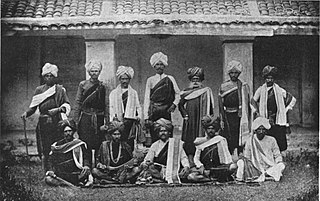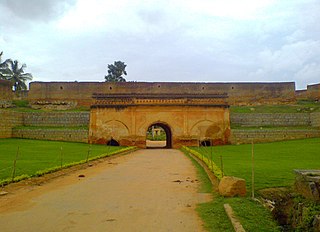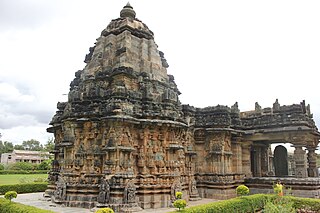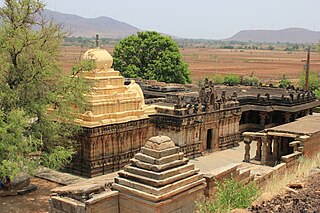Related Research Articles

Kodagu district is an administrative district in the Karnataka state of India. Before 1956, it was an administratively separate Coorg State, at which point it was merged into an enlarged Mysore State.

Kodachadri is a mountain peak with dense forests in the Western Ghats in South India, 78 km from Shimoga. Kodachadri is the highest peak in Shivamogga district. It is declared as natural heritage site by the Karnataka Government. and it is 13th highest peak of Karnataka.

Kempe Gowda I locally venerated as Nadaprabhu Kempe Gowda, or commonly known as Kempe Gowda, was a governor under the Vijayanagara Empire in early-modern India. He is famous for the development of Bangalore Town in the 16th century. Kempegowda erected many Kannada inscriptions across the region.

Keladi is a temple town in Sagara Taluk of the state of Karnataka in India. Keladi is located about 8 km from the town of Sagara.

Bangalore is the capital city of the state of Karnataka. Bangalore, as a city, was founded by Kempe Gowda I, who built a mud fort at the site in 1537. But the earliest evidence for the existence of a place called Bangalore dates back to c. 890.

Devanahalli, also called "Devandahalli", "Dyaavandalli", Devanadoddi, and Devanapura, is a town and Town Municipal Council in Bengaluru Rural district in the state of Karnataka in India. The town is located 40 kilometres (25 mi) to the north-east of Bengaluru. Devanahalli is the site of Kempegowda International Airport. A multibillion-dollar Devanahalli Business Park with two IT Parks are coming up on nearly 400 acres (1.6 km2) adjoining the airport. An Aerospace Park, Science Park and a ₹10 billion (US$120 million) Financial City are also coming up. A new satellite ring road will connect the city with Doddaballapur. Devanahalli is situated near the upcoming ₹1,500 billion (US$18 billion), 12,000-acre (49 km2) BIAL IT Investment Region, to be the largest IT region in India.

Vokkaliga is a community of closely related castes, from the Indian states of Karnataka and Tamil Nadu.
The Vrishabhavathi River is a minor river, a tributary of the Arkavathy, that flows through the south of the Indian city of Bangalore. The river was once so pristine that the water from it was used for drinking and used by the famous Gali Anjaneya temple but is now highly polluted due to pollutants from industrial, agricultural and domestic sources.

Magadi is a town and taluk located in Bengaluru South district, Karnataka, India.

The Ishvara temple, also referred to as the Ishwara or Isvara temple, is an early 13th-century Hindu temple in Arsikere, Hassan district, Karnataka India. Dedicated to Shiva, it is one of the most notable early Hoysala architecture examples with a rotating circular plan, a domed mandapa with 16-point star shape, a pancatala vimana, and a galaxy of artwork depicting Shaivism, Vaishnavism, Shaktism and Vedic legends of Hinduism.

Bangalore Fort began in 1537 as a mud fort. The builder was Kempe Gowda I, a vassal of the Vijaynagar Empire and the founder of Bangalore. King Hyder Ali in 1761 replaced the mud fort with a stone fort and it was further improved by his son King Tipu Sultan in the late 18th century. It was damaged during an Anglo-Mysore war in 1791. It still remains a good example of 18th-century military fortification. The army of the British East India Company, led by Lord Cornwallis on 21 March 1791 captured the fort in the siege of Bangalore during the Third Mysore War (1790–1792). At the time the fort was a stronghold for King Tipu Sultan. Today, the fort's Delhi gate, on Krishnarajendra Road, and two bastions are the primary remains of the fort. A marble plaque commemorates the spot where the British breached fort's wall, leading to its capture. The old fort area also includes King Tipu Sultan's Summer Palace, and his armoury. The fort has provided the setting for the treasure hunt in the book Riddle of the Seventh Stone.

Halasuru Someshwara Temple is located in the neighborhood of Halasuru in Bangalore, Karnataka, India. It is one of the old temples in the city dating back to the Chola period, it is dedicated to the Hindu god Shiva. Major additions or modifications were made during the late Vijayanagara Empire period under the rule of Hiriya Kempe Gowda II.

Devanahalli Fort is located 35 kilometers (22 mi) north of Bangalore city, at Devanahalli in the State of Karnataka, India. Chieftain Malla Byre Gowda of Avathi, a Vijayanagara empire vassal, built a mud fort in c. 1501 at Devanadoddi. In the late 18th century, Hyder Ali re-constructed the fort in stone resulting in the current structure.

The Kunchitigas are a community of people from Karnataka, India. They are mostly concentrated in the Tumkur, Bangalore, Mysore, Ramanagara, Shivamogga and Chitradurga districts. They are also found in Tamil Nadu.

The Kalleshwara temple is located in the town of Hire Hadagali of the Hoovina Hadagalitaluk in Vijayanagara district of Karnataka state, India.

The Kalleshvara temple is located in the town of Ambali in Bellary district of Karnataka state, India. According to an Old Kannada inscription placed in the sabhamantapa, the temple was constructed during the reign of the Western Chalukya Empire King Vikramaditya VI. This temple is protected as a monument of national importance by the Archaeological Survey of India.

Kalleshwara temple is located in the village of Bagali it was 9km away from Harpanahalli city in the Vijayanagara district of Karnataka state, India.
Gowda is a surname native to Karnataka state of India. It is mainly found among the Vokkaligas in South Karnataka, Kuruba Gowda and the Lingayats in north Karnataka. It is also used by other communities like Namadhari Naiks, Billavas. Gowda was originally an honorific used by the administrative head of a village. Typically, such a head owned land and held political and social sway in the village. Among Reddy, it was used to refer to the head of the community.
Kalya (Kalavathi pattana) or Kalya is a historic settlement located in Magadi Taluk, Bengaluru South district of Karnataka, India. Kalya as an early settlement can be attested by prehistoric rock art and tools reported from Kalya and inscriptional evidence in the village starting from 550 CE to the early 17th century CE, making it one of the few places in the country that has been continuously inhabited for 3000 to 3500 years.
References
- ↑ Various Census of India. 1875. p. 340.
- ↑ Mysore (India : State). Archaeological Department (1913). Annual Report of the Mysore Archaeological Department for the Year 1913. University of Mysore. p. 110.
- ↑ Gowda, Deve; Gowda, Javare. Village Names of Mysore District: An Analytical Study. 1998: Asian Educational Services. p. 52. ISBN 8120613902 . Retrieved 7 September 2015.
{{cite book}}: CS1 maint: location (link)